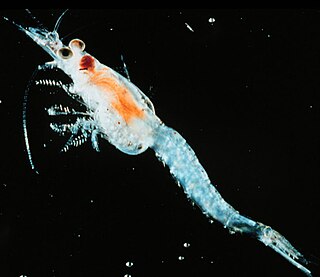Related Research Articles

Mysida is an order of small, shrimp-like crustaceans in the malacostracan superorder Peracarida. Their common name opossum shrimps stems from the presence of a brood pouch or "marsupium" in females. The fact that the larvae are reared in this pouch and are not free-swimming characterises the order. The mysid's head bears a pair of stalked eyes and two pairs of antennae. The thorax consists of eight segments each bearing branching limbs, the whole concealed beneath a protective carapace and the abdomen has six segments and usually further small limbs.

Mysidae is the largest family of crustaceans in the order Mysida, with over 1000 species in around 170 genera.

Mysis is a genus of mysid crustaceans in the family Mysidae, distributed mainly in the coastal zone of the Arctic and high boreal seas. Several species also inhabit northern freshwater lakes and the brackish Caspian Sea. Fifteen species are recognized. Body lengths range from 1 to 3 centimetres.

Acanthacaris is a genus of deep-water lobsters. It contains two species, A. caeca and A. tenuimana, and is the only genus in the subfamily Neophoberinae.

Paramysis is a genus of mysid crustaceans (Mysidacea) in family Mysidae, distributed in coastal zone of low boreal East Atlantic Ocean, Mediterranean Sea and the basins of Black Sea, Sea of Azov and Caspian Sea.

Mysis diluviana is a mysid crustacean found in freshwater lakes of northern North America.

Paramysis baeri is a species of mysid crustacean from the genus Paramysis, named in honour of the prominent biologist Karl Ernst von Baer. Its body is 13–31 millimetres (0.51–1.22 in) long, and it is only found in the coastal waters of the Caspian Sea, on sandy and muddy bottoms, at depths of less than 20 m (66 ft). For over a century, it was thought to be distributed throughout the whole Ponto-Caspian basin, but recently the range was reconsidered after the rediscovery and re-establishment of the closely related species Paramysis bakuensis. Since the taxonomical status of P. baeri has been reconsidered, the distribution and ecology of the species remains poorly known. Paramysis baeri can be distinguished from P. bakuensis and other species of the subgenus Paramysis s. str. by the rather broad, almost quadrangular exopod of maxilla 2, the strongly serrated paradactylar claw-setae of pereiopod 6, and other features.
Paramysis bakuensis is a species of mysid crustacean from the family Mysidae, named by the locality from where it was originally described, the town of Baku in Azerbaijan by the Caspian Sea.
Petalophthalmidae is a family of marine crustaceans in the order Mysida, the opossum shrimps.

Heteromysis is a genus of marine mysid crustaceans from the family Mysidae, associated with various shallow-water invertebrates. The name describes differentiation of its pereiopods as possible adaptation to commensal life-style. Heteromysis is one of the largest mysid genera, containing more than 100 species. The genus is distributed globally, but predominantly in tropical and subtropical waters.
Victor Vladimirovich Petryashov was a Russian zoologist, carcinologist, hydrobiologist and biogeographer. His scientific research focused on taxonomy and distribution of malacostracan crustaceans, particularly orders Mysida, Lophogastrida and Leptostraca, and marine biogeography and hydrobiology of Arctic, Antarctic and temperate seas of the World, and he published over 120 works. V.V. Petryashov spent all his professional life in St. Petersburg in the Zoological Institute of the Russian Academy of Sciences. As a senior researcher he also curated the malacostracan crustacean collection of the Zoological Institute.

Callichirus major sensu lato is a monophyletic species complex of ghost shrimp in the infraorder Axiidea, found in flat sandy beaches across the Pan-American coastline.
Neobirsteiniamysis is a mysid crustacean genus of the subfamily Boreomysinae of the family Mysidae. Some of the largest mysids. Exclusively deep water. Cosmopolitan. 2 species.
Neobirsteiniamysis inermis is a deepwater mysid crustacean species of the genus Neobirsteiniamysis. One of the largest and the only known mysid, distributed in both polar regions.
Boreomysinae is a subfamily of large, mostly deep-water oceanic mysid crustaceans from the family Mysidae. The name, which can be translated as "northern mysids", comes from the genus Boreomysis G.O. Sars, 1869, established for Boreomysis arctica from the boreal waters of Atlantic. As more species have been discovered subsequently, the subfamily is considered panoceanic, and includes 38 species from two genera, Boreomysis and Neobirsteiniamysis Hendrickx et Tchindonova, 2020.
Boreomysis inopinata is a species of mysid crustaceans from the subfamily Boreomysinae. It is also a member of the nominotypical subgenus Boreomysis sensu stricto. The species is a deepwater bathypelagic mysid, found only from the Tasman Sea off Australia.
Boreomysis sibogae is a species of mysid crustaceans from the subfamily Boreomysinae. It is also a member of the nominotypical subgenus Boreomysis sensu stricto. The species is an epi-bathypelagic mysid, widely distributed in the Indo-Pacific and possibly also in the Atlantic Ocean.
Boreomysis sphaerops is a species of mysid crustaceans from the subfamily Boreomysinae. It is also a member of the nominotypical subgenus Boreomysis sensu stricto. The species is a meso-bathypelagic mysid, distributed in the West Indo-Pacific, although known only from few records off Japan and Australia.
Boreomysis urospina is a species of mysid crustacean from the subfamily Boreomysinae. It is also a member of the subgenus Petryashovia. The species is a mesopelagic mysid, found only in the Tasman Sea, off Australia.

Heteromysinae is a subfamily of predominantly marine mysid crustaceans from the family Mysidae.The name comes from the genus Heteromysis and describes differentiation of the pereiopods in the type genus. In its current sence, however, not all members of the subfamily share this feature. Heteromysines are distributed globally and include about 150 species, divided between three tribes: Heteromysini, Harmelinellini and Mysidetini.
References
- 1 2 3 4 5 6 7 8 Daneliya, M. E. "Mysid subfamily Boreomysinae (Crustacea: Mysida: Mysidae)". Records of the Australian Museum . 75 (2). doi: 10.3853/j.2201-4349.75.2023.1845 . hdl: 10138/357511 .
- ↑ Jan Mees; Kenneth Meland (2012). "Boreomysis". WoRMS. World Register of Marine Species . Retrieved August 18, 2023.
- ↑ Ii, N. (1964). Fauna Japonica, Mysidae (Crustacea). Biogeographical Society of Japan.